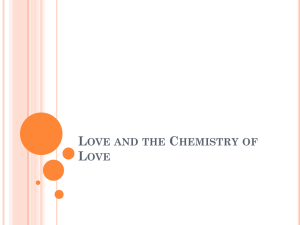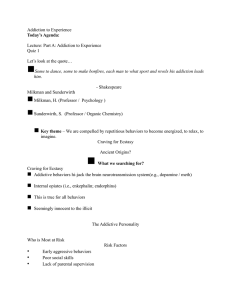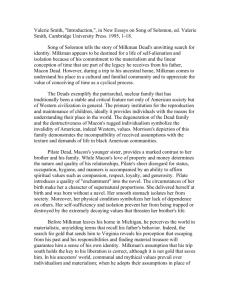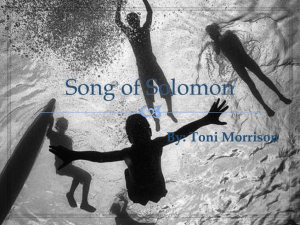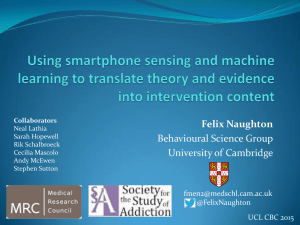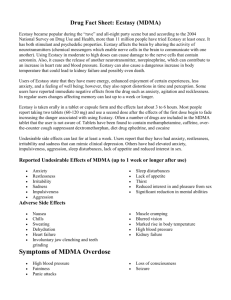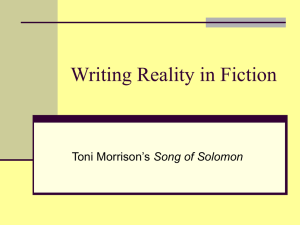+ Addiction to Experience Today’s Agenda: Lecture: Part A Addiction to Experience
advertisement
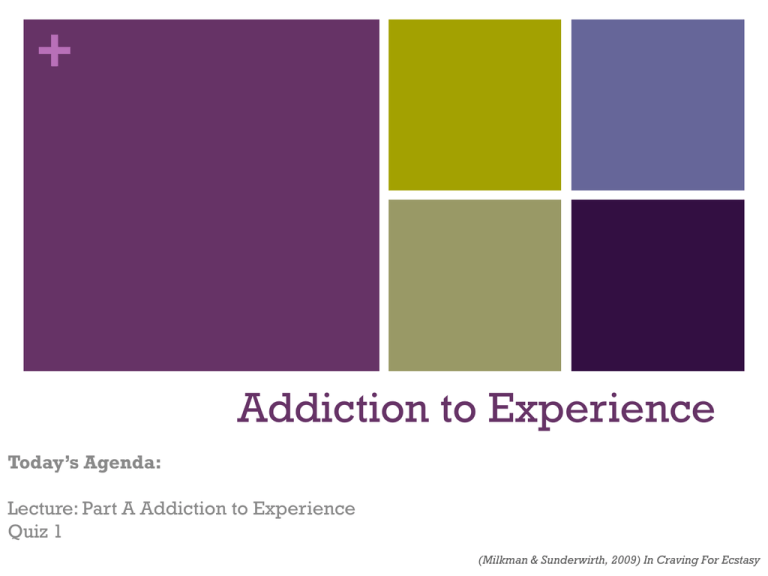
+ Addiction to Experience Today’s Agenda: Lecture: Part A Addiction to Experience Quiz 1 (Milkman & Sunderwirth, 2009) In Craving For Ecstasy + Let’s look at the quote… Some to dance, some to make bonfires, each man to what sport and revels his addiction leads him. - Shakespeare (Milkman & Sunderwirth, 2009) In Craving For Ecstasy + Milkman and Sunderwirth Milkman, H. (Professor Sunderwirth, S. / Psychology ) (Professor / Organic Chemistry) Key theme – We are compelled by repetitious behaviors to become energized, to relax, to imagine. (Milkman & Sunderwirth, 2009) In Craving For Ecstasy + Craving for Ecstasy Ancient Origins? What we searching for? (Milkman & Sunderwirth, 2009) In Craving For Ecstasy + Craving for Ecstasy Addictive behaviors hi-jack the brain neurotransmission system(e.g., dopamine / meth) Internal opiates (i.e., enkephalin; endorphins) This is true for all behaviors Seemingly innocent to the illicit (Milkman & Sunderwirth, 2009) In Craving For Ecstasy + The Addictive Personality Rule breaking Deviant Addictive Personality Depressed (Milkman & Sunderwirth, 2009) In Craving For Ecstasy Nonconformist + Who is Most at Risk Risk Factors 1. 2. 3. 4. 5. 6. Early aggressive behaviors Protective Factors 1. Self-control 2. Positive Relationships 3. Parental monitoring / support 4. Academic competence 5. Anti-drug use policies 6. Strong neighborhood attachment Poor social skills Lack of parental supervision Substance abuse Drug availability Poverty (National Institute on Drug Abuse, 2008) + More risk factors greater chance of entering into risky behaviors leads to compulsion (Milkman & Sunderwirth, 2009) In Craving For Ecstasy + Euphoric / Dysphoric Cycle Brain is at baseline Addictive behavior releases dopamine Euphoria (learn cues from environment) Stop /moderate or Cannot control activity Dysphoria (Milkman & Sunderwirth, 2009) In Craving For Ecstasy + Drug and Activities of Choice Genetics > behavioral style > stress “Not Good Enough Self” Surrender to something outside ourselves This surrender often depends on our way of coping with stress Certain personalities appear to gravitate toward certain addictive behaviors to shore up stress and ameliorate “not good enough self” (Milkman & Sunderwirth, 2009) In Craving For Ecstasy + The Serendipitous Event We find our drug of choice – reduce stress / inner turmoil Incipient Addicts – experience compulsions and loss of control long before ingesting psychoactive substances For instance, family problems, school truancy / violence / crime / interpersonal relations, par-suicidal behaviors Three avenues of experience to ameliorate psychic pain (Milkman & Sunderwirth, 2009) In Craving For Ecstasy + Antidotes for Psychic Pain Satiation, arousal, and fantasy These antidotes may have origins in first years of life Childhood experiences and genetics foundation of adult compulsion Our three antidotes correlate with drug of choice 1. 2. 3. Depressants Stimulants Hallucinogens (Milkman & Sunderwirth, 2009) In Craving For Ecstasy + Milkman and Sunderwirth (2009) hold that: People don’t become addicted to drugs or mood altering activities as such, but rather to the satiation, arousal, or fantasy experiences that can be achieved through them. (Milkman & Sunderwirth, 2009) In Craving For Ecstasy + Satiation Addict “Soother” Binge on food Television Choice of drug – depressants (alcohol, benzodiazepines) Striking similarity to child during first year of life (food and warmth Pharmacologic defense against user’s own aggressive drives Similar to opiates (Milkman & Sunderwirth, 2009) In Craving For Ecstasy + Arousal Addict “Sensation Seekers” Seek stimulation / risk takers / live on the edge Gamblers Cocaine and amphetamine users Can be criminals Seek to be active and potent in their environment (boastful) Their vast expenditures of mental and physical energy are designed to deny underlying fear and helplessness (Milkman & Sunderwirth, 2009) In Craving For Ecstasy + Fantasy Addict: “Dreamer / Mystic” Favors repetitive activation of right-hemisphere thinking Preoccupation with altered reality Mystical insights / pursuit of merge with divine LSD Mushrooms High potent marijuana Try to overcome fears by creating fantasies in which they are effective and important (Milkman & Sunderwirth, 2009) In Craving For Ecstasy + The Brain, Antidotes, and Behavior (Milkman & Sunderwirth, 2009) In Craving For Ecstasy The Deviant Career (Milkman & Sunderwirth, 2009) In Craving For Ecstasy + Basic Neuro-Chemistry Brain an electrical-chemical computer Process of communication between neurons (neurotransmission) Largely responsible for brain functions that determine what we are (i.e., personality, intellect, and character) We are our neurotransmission (Milkman & Sunderwirth, 2009) In Craving For Ecstasy + Pre – Postsynaptic Neuron Critical Point (Milkman & Sunderwirth, 2009) In Craving For Ecstasy + Lock and Key, Release, Block Neurotransmitters released from presynaptic attach themselves to the receptors in the postsynaptic much like a lock and key Some drugs will increase the activation of neurotransmitter release (amphetamine) While others will block the reuptake of neurotransmitters (cocaine) expanding the available dopamine in the synapse. (Milkman & Sunderwirth, 2009) In Craving For Ecstasy Blum’s Reward Cascade + + Drugs, Dopamine Levels, Nucleus Accumbens + Activity, Dopamine Level, and Nucleus Accumbens + Drugs and Dopamine Release Amphetamine 900% Cocaine 200% Heroine 160% Marijuana 130% Nicotine 100% (Milkman & Sunderwirth, 2009) In Craving For Ecstasy + Drugs to fight Drugs Vigabatrin – Used to stop cocaine cravings Campral – reduce cravings (alcohol) Naltrexone (blocks intoxicating affects of alcohol) Vivitrol (longer last than the Naltrexone – injectable) (Milkman & Sunderwirth, 2009) In Craving For Ecstasy

